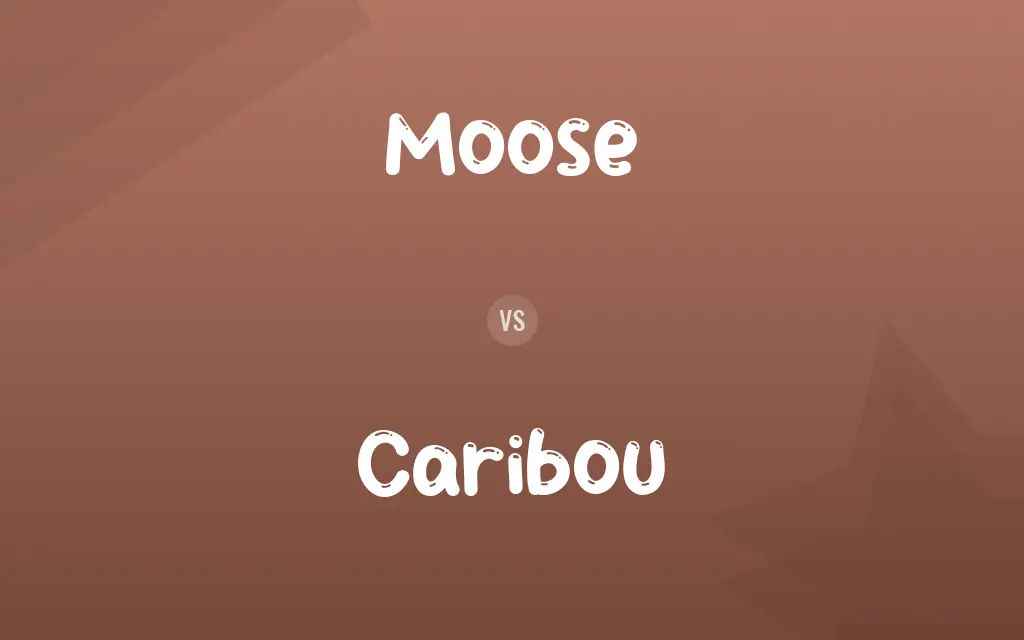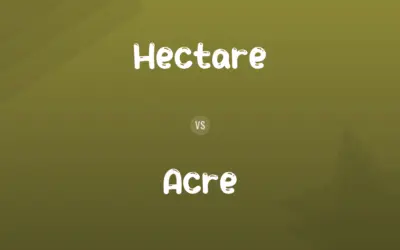Moose vs. Caribou: Difference and Comparison
Edited by Muazma Batool — By Muneeza Rehman — Published on March 12, 2024
Moose and caribou are large, antlered mammals, but moose are solitary and prefer wetlands, while caribou, also known as reindeer, are herd animals adapted to cold, tundra regions.

Difference Between Moose and Caribou
Moose are the largest members of the deer family, characterized by their massive size, long faces, and the males' distinctive broad, palmate antlers. Caribou, on the other hand, are known for their migration, living in arctic and subarctic regions. Both male and female caribou grow antlers, which is unusual among deer species. They are adapted to cold environments with features like large, fur-covered hooves for walking on snow.
Muneeza Rehman
Mar 12, 2024
Moose are solitary and do not migrate, preferring to stay within a certain range that provides their food and shelter needs, caribou are notable for their extensive migratory patterns, driven by seasonal changes and the search for food. This difference in social structure and movement patterns highlights the adaptations each species has made to their specific environments.
Muneeza Rehman
Mar 12, 2024
The conservation status and threats to these animals also differ. Moose populations are generally stable but face threats from habitat loss and hunting. Caribou, particularly certain subspecies, face more severe threats from climate change, habitat destruction, and disturbances in their migratory paths, leading to significant population declines in some areas.
Muneeza Rehman
Mar 12, 2024
Despite these differences, both moose and caribou play significant roles in their ecosystems and cultural importance in the regions they inhabit, symbolizing the wilderness and natural beauty of the Northern Hemisphere.
Henry
Mar 12, 2024
Moose vs. Caribou Comparison Chart
Habitat
Forested areas near water in Northern Hemisphere
Arctic and subarctic tundra
Muneeza Rehman
Mar 12, 2024
Antlers
Males have broad, palmate antlers
Both males and females grow antlers
Muneeza Rehman
Mar 12, 2024
Adaptations
Large size, preference for wetlands
Large hooves, fur-covered for cold resistance
Henry
Mar 12, 2024
Conservation Status
Generally stable but varies by region
Varies, with some populations endangered
Elijah
Mar 12, 2024
Moose vs. Caribou Definitions
◉Moose
Males are distinguished by their large, palmate antlers.
The male moose sheds its antlers annually after the mating season.
Lucas
Feb 21, 2024
◉Caribou
Adapted to cold environments, caribou are known for their migratory habits.
The caribou herd migrates hundreds of miles to winter feeding grounds.
Muneeza Rehman
Feb 21, 2024
◉Moose
Non-migratory, staying within a defined home range.
Moose in the region tend to stay within the same forested area year-round.
William
Feb 21, 2024
◉Caribou
Both males and females grow antlers, a unique trait among deer.
Female caribou use their antlers to compete for food in winter.
Henry
Feb 21, 2024
◉Moose
Faces threats primarily from habitat loss and hunting.
Conservation efforts aim to protect moose habitats from encroachment.
Henry
Feb 21, 2024
◉Caribou
Conservation status varies, with some populations at risk.
Climate change poses a significant threat to caribou migration patterns.
Levi
Feb 21, 2024
◉Moose
The largest species in the deer family, known for their size and solitary nature.
A moose was spotted foraging alone near the lake.
Muneeza Rehman
Feb 21, 2024
◉Caribou
Their hooves adapt to various terrains, from snow to wetlands.
Caribou's hooves allow them to traverse snowy landscapes efficiently.
Kaitlyn
Feb 21, 2024
◉Moose
Prefers wetlands and dense forests for habitat.
The moose uses wetlands as feeding grounds during summer.
William
Feb 21, 2024
◉Caribou
Lives in arctic and subarctic regions, forming large herds.
Large herds of caribou are a common sight in the tundra.
Muneeza Rehman
Feb 21, 2024
◉Moose
A large deer (Alces alces) of northern North American and Eurasian forests, having a broad pendulous muzzle, humped shoulders, and large, palmate antlers in the male.
Muneeza Rehman
Feb 20, 2024
◉Caribou
A large deer (Rangifer tarandus) of the Arctic tundra and northern boreal forests, having large hooves and long branched antlers. Subspecies native to Eurasia are usually called reindeer.
Muneeza Rehman
Feb 20, 2024
◉Moose
The largest member of the deer family (Alces americanus, sometimes included in Alces alces), of which the male has very large, palmate antlers.
We saw a moose at the edge of the woods.
Muneeza Rehman
Feb 20, 2024
◉Caribou
Any of several North American subspecies of the reindeer, Rangifer tarandus.
Muneeza Rehman
Feb 20, 2024
◉Caribou
The American reindeer, especially the common or woodland species (Rangifer Caribou).
Muneeza Rehman
Feb 20, 2024
Moose vs. Caribou Frequently Asked Questions
Do all moose have antlers?
Only male moose grow antlers, which they shed and regrow annually.
Muneeza Rehman
Mar 12, 2024
Why do caribou migrate?
Caribou migrate to access different food sources and for breeding, adapting to the harsh conditions of their arctic habitats.
Muneeza Rehman
Mar 12, 2024
Can moose and caribou interbreed?
No, despite being in the same family, they are different species with significant biological differences.
Olivia
Mar 12, 2024
Can moose and caribou be found in the same habitat?
Rarely, as moose prefer forested areas and caribou are adapted to arctic tundra environments.
Muneeza Rehman
Mar 12, 2024
Are caribou and reindeer the same species?
Yes, caribou and reindeer refer to the same species, with "reindeer" typically used in Europe and Asia, and "caribou" in North America.
Elijah
Mar 12, 2024
How do caribou survive in the cold?
Caribou have dense fur, large hooves for walking on snow, and a fat layer for insulation.
Kaitlyn
Mar 12, 2024
What do moose eat?
Moose are herbivores, feeding on leaves, twigs, and aquatic vegetation.
Leo
Mar 12, 2024
How do moose defend themselves?
Moose use their size, speed, and antlers to defend against predators and during mating competitions.
William
Mar 12, 2024
How do caribou antlers differ from those of other deer?
Caribou antlers are unique in that both males and females grow them, and they have a denser, more branched structure.
Kaitlyn
Mar 12, 2024
What threats do moose and caribou face?
Both species face threats from habitat loss, climate change, and predation by wolves and bears.
Elijah
Mar 12, 2024
Content Creators
Written by
Muneeza RehmanAt Comparisons.wiki, Muneeza skillfully navigates the vast sea of information, ensuring clarity and accuracy as the lead content editor. With a keen eye for detail, she curates every comparison to enlighten and engage readers.
Edited by
Muazma BatoolAs a content editor, Muazma Batool is not just a grammar guru but a creative mastermind who breathes life into every word. With an eagle eye for detail and a passion for storytelling, she transforms bland text into engaging content that captivates audiences and drives results.
































